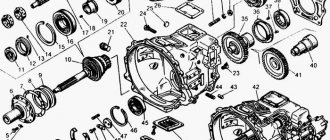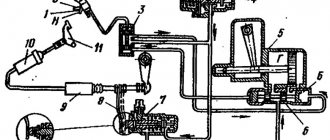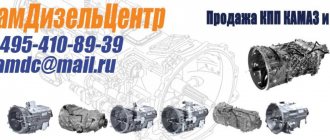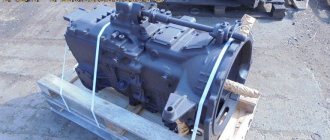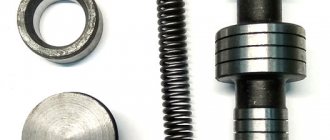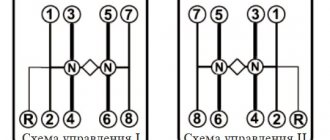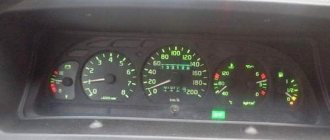Good afternoon
I purchased a gearbox 152 with a new type air distributor for two tubes.
Before this there was a 15 gearbox with a distributor for three tubes. How to supply air?
Please tell me.
- Login or register to post comments
The procedure for replacing an old-style air distributor with a new one
Gearbox 152 is currently equipped with an MPDP-1771010A .
Its difference is that instead of the air distributor 15-1772010, B2111-4.00.000B with two holes is installed.
One outlet is the input for constant air supply, and the second one is supplied with air from the divider control valve for switching lower or higher speeds.
Iron tubes are currently not used on the KAMAZ conveyor, so polyamide tubes need to be used.
The procedure for switching to a new model is described in detail in the “Bulletin for dealers and service centers of KAMAZ OJSC” , information letter No. 17-393-2011, October 2011. For your convenience, I present this procedure in full below.
In connection with the restructuring and cessation of production of some components and parts of KAMAZavtotekhnika LLC, if it is necessary to replace the gear divider switching mechanisms 15.1771010, 15.1771010-10 and 15.1771010-20 on vehicles, it is allowed to install instead of them MPDP-1771010A manufactured by Saratovdieselapparat, used for gearboxes 152 and 154 since November 2009
Additionally, on the car you need to do the following:
When replacing mechanism 15.1771010-20 with MPDP-1771010A, it is necessary to remove pressure reducing valve 15.1772100 from the gearbox, connect the air tubes to the air distributor on MPDP using an elbow fitting D6502 8-M12G—1.5-S and a straight fitting DS6510 4-M10G—1-S .
The appearance of the gearbox with MPDP is attached on the left in Figure 1 . You should click on the thumbnail to view the drawing in full size.
Before installing MPDP-1771010A instead of mechanism 15.1771010-10 , it is necessary to disconnect the air distributor located at the lower end of the cylinder from the MPDP.
When installing MPDP-1771010A instead of mechanism 15.1771010 on gearboxes 152 and 154 for vehicles with a gear shift knob in the cab that has a divider control valve 15.1772132 and plastic tubes for pneumatic control of the divider, it is necessary to remove the pressure reducing valve 15.1772100 from the gearbox, disconnect the tube from the hole marked “B” on the divider control valve 15.1772132, plug this hole with a bolt 1/59703/21 M10x1.25-6gG—16 with gasket 1/02844/60, connect the air tubes to the air distributor on the MPDP using an angle fitting D6502 8-M12G—1.5- S and straight fitting DS6590 6-M10G—1-S.
On vehicles without a divider control valve under the clutch pedal, i.e. with metal tubes for pneumatic control of the divider, when replacing mechanism 15.1771010 with MPDP-1771010A, it is necessary to perform work according to step 3 and additionally connect plastic air supply tubes with a diameter of 6 mm in accordance with Figure 2 on the right (click on the thumbnail to view the drawing in full size)..
Best regards, Vladimir Danielyan.
Head of the purchasing department of the central branch of NPO KamAgregat-Service, Naberezhnye Chelny.
KAMAZ gearboxes of the 15th model (152 and 154) use an additional single-stage gearbox - a divider, which doubles the total number of gears. The divider is controlled pneumatically using a special mechanism - this mechanism is described in detail in this article.
GEARBOX WITH DIVIDER ON KAMAZ: DEVICE AND PRINCIPLES OF USE
The gearbox installed on a KamAZ vehicle is a rather complex device. This mechanism makes it easy to drive the truck. However, the driver, even if he has theoretical knowledge about the design and operation of a KamAZ gearbox with a divider, in practice may initially encounter serious problems when trying to use the gearbox to change vehicle speeds.
Kamaz gearbox: device, divider, switching diagram
For a car, the gear shift mechanism is a device, without which operation is unthinkable. If in passenger vehicles the transmission is not considered a simple unit, then in heavy equipment due to its size and weight, things are much worse. Therefore, the KamAZ gearbox is a structurally complex device that requires skills and abilities when handling and maintaining.
Most foreign manufacturers install automatic transmissions on heavy equipment. The creators of KamAZ, in order to simplify the design and increase the reliability of the product, followed the path of a mechanical device. The KamAZ gearbox diagram increases the effect of using the vehicle. Simplicity and convenience make the unit cost-effective.
Principles of KamAZ gearbox design
KamAZ vehicles are mostly equipped with two types of gearboxes: those with five and ten steps, respectively, these are models 14 and 15. Five-speed gearboxes are more often used on vehicles used as individual vehicles, while 10-speed gearboxes are more preferable for trucks included in road trains. The 10-speed gearbox design includes a conventional five-speed gearbox and a splitter gearbox. This KamAZ gear divider, used in conjunction with a five-speed gearbox, allows the vehicle to use 10 forward speeds and 2 reverse.
With the start of production of trucks, the technical characteristics of which provided for a significantly greater carrying capacity, specialists from the Kama Automobile Plant developed a new gearbox model, designated 152. The list of main differences and improvements in this box includes:
- reinforced KamAZ gearbox divider synchronizer;
- strengthening the splines and removing their fasteners;
- new method of fastening gearbox gears;
- increasing the height of the teeth.
In the updated version, control and switching operations of the divider are performed by a pneumatic system. During the operation of the KamAZ gearbox, it is very important that maintenance, fault diagnosis, repair, assembly and replacement of parts are carried out by highly qualified specialists with the appropriate knowledge and practical skills, as well as the necessary equipment and tools.
The design of the KamAZ 152 five-speed gearbox includes the following components and parts:
- crankcase, which contains the KamAZ primary, secondary and intermediate shafts;
- a block of gears responsible for engaging reverse gear;
- upper gearbox cover;
- collapsible gear shift mechanism;
- divider mounted on the front of the crankcase.
The KamAZ gearbox, equipped with a gearbox, has a number of positive qualities, including a reduced gear shift frequency, increased traction and simplified vehicle control.
Diagram of operation of a gearbox with a divider
Most KamAZ trucks in use today are equipped with five-speed manual transmissions. The gear shift pattern in such gearboxes is quite familiar: the driver depresses the clutch and moves the lever to the required position. It is important to understand that KamAZ vehicles are heavy-duty trucks, that is, adjusting the position of the lever must be done strictly in stages.
The typical transmission modes for a truck with a diesel engine are low (“H”) and high (“B”) operating modes. The development of these two options was carried out specifically in order to minimize the load on the engine of the machine, both with a maximum load and when empty. Many KamAZ vehicle models allow you to switch these modes without using the gearshift lever. The driver just needs to raise or lower a special divider switch and literally squeeze the clutch for a second. The mode is adjusted automatically: a lowered switch activates a light driving mode, and a raised switch activates a stronger driving mode.
Dealing with switching gearbox modes on KamAZ trucks is relatively simple. To change gears 1-5, use the corresponding lever located to the right of the driver's seat. For example, acceleration of a truck involves the use of the following gear shift pattern: 1B-2B-3B-4Н-4B-5Н-5B. On a clogged highway or in difficult road conditions, use 1H-2H-ЗH-4H-4В-5H-5В.
It should be borne in mind that the KamAZ gearbox device allows you to change speeds only if the clutch is disengaged. To switch from the upper mode to the lower one and vice versa, you need to move the switch to the appropriate position and only then press the clutch all the way and as sharply as possible. Literally in a second you need to release the pedal for the desired main gear to engage.
During the operation of the vehicle, it is very important to monitor how much oil is in the KamAZ gearbox, and, as necessary, add lubricant in a timely manner, preventing possible problems and malfunctions.
Divider control
The gearbox and divider on KamAZ provide a standard mechanical control mode. The gearbox control is a gear selection mechanism with three forks responsible for gear ratios. The divider control system (abbreviated as MPPD, divider gear shift mechanism) provides only one fork mounted on its own shaft, which extends from the box body and is connected to the lever at the rear. To interact the fork with the clutch, a divider block mounted in the synchronizer carriage is used.
The MPPD is equipped with a pneumomechanical drive, in which the speeds are switched due to the force of compressed air received from the vehicle’s pneumatic system. Disassembly allows you to isolate and inspect the main components and assemblies:
Features of the design and operation of KAMAZ gearboxes
KAMAZ trucks are currently equipped with a fairly large number of gearbox models, which, with minimal design differences, have different characteristics:
- Gearbox 14 model range - models 141, 142 and 144;
- Model range of gearbox 15 - models 152 and 154;
- Model range of gearbox 16 - represented by one model 161;
- Gearboxes manufactured by ZF-KAMA - a wide variety of manual transmission models 6S, 9S and 16S, automated gearboxes 12A and automatic gearboxes 6H.
Gearbox 14 is the simplest 5-speed three-way gearbox with manual control and synchronizers. They are installed mainly on dump trucks and other single vehicles operated without trailers.
Gearbox 15 is a modernized Gearbox 14, to which a divider has been added. Thanks to the use of a divider, the number of gears is doubled (up to 10 forward and two reverse). The divider is a single-stage gearbox, built on one pair of conventional cylindrical (usually helical) gears, installed between the clutch and the gearbox (in fact, it is located in the clutch bell, which is integral with the gearbox housing). The divider has pneumomechanical control; if necessary, direct or reduction gear is engaged, due to which the total number of gearbox speeds is doubled.
Gearbox 16 (model 161) is an 8-speed gearbox with manual control, which uses a planetary range shifter instead of a divider. In fact, this is a 4-speed ZF gearbox, in which the total number of gears is doubled due to the planetary gearbox. This box is produced by the ZF-KAMA joint venture.
The ZF-KAMA gearbox is a wide range of mechanical, automated and automatic transmissions that are installed on all KAMAZ trucks and a number of KAMAZ bus chassis on which NefAZ buses are built. Today, model ranges of 6-speed manual and automatic transmissions, 9 and 16-speed manual transmissions (with range-shifters), and 12-speed automated gearboxes are produced.
Boxes of model series 15 with a divider, which in general have a simple device, are very widespread. The divider is assembled on a pair of gears mounted on shafts. The input shaft gear is mounted on bearings, the secondary shaft gear is rigidly secured with a key. In this case, the input shaft of the divider is coaxial with the input shaft of the gearbox and they can be connected using a synchronizer clutch. The intermediate shafts of the gearbox and divider are also on the same axis and are always rigidly connected to each other.
Direct (or overdrive) and downshift gears are engaged using a synchronizer clutch on the input shaft; it has two positions:
- Front - in this case, the gear is blocked by the clutch, as a result of which the torque from it is transmitted to the intermediate shaft gear, and from it directly to the secondary shaft of the gearbox. This is how the downshift is engaged;
- Rear - in this case, the clutch connects the input shafts of the divider and the gearbox, simultaneously releasing the divider gear, as a result, the torque from the clutch along the input shaft of the divider gearbox directly goes to the input shaft of the gearbox without change.
Switching gearbox speeds and divider modes is carried out by various controls, which need to be discussed separately.
What is the divider used for?
The divider is a mechanical gearbox that serves to increase the gear ratios of the main gearbox. That is, when low gear is engaged, the rotation of the input shaft of the divider is transmitted directly to the input shaft of the gearbox.
If the divider is switched to a higher gear, the rotation of the input shaft is transmitted to its intermediate shaft, which is directly connected to the intermediate shaft of the main gearbox. Such switching is carried out using a synchronizer.
The gears in the divider are switched by a synchronizer, the carriage of which is moved by the piston of a pneumatic cylinder directly through the lever and fork of the divider. The pneumatic divider control system consists of several mechanisms by which gears in the divider are changed.
Box divider
High and low operating modes, a feature of KamAZ gearboxes. This specificity is caused by the desire to reduce the load on the power plant. It is typical that it does not matter whether the machine is loaded or not. A divider is a gearbox based on the principle of mechanics and increases gear ratios. The mechanism is started using a switch on the rocker.
KamAZ-15 box divider input shaft:
- The valve that controls the device. The part is attached to the base of the switch, uses direct and reduced speed modes.
- A valve that maintains a constant outlet pressure. It takes compressed air and resets the pressure in the system when the established values are exceeded. Transfers air to the control valve and to the valve of the dividing device from the air unit. Thanks to manipulations, there are simultaneously two circuits in the engine control system.
- Divider activation valve. Supplies air pressure to the device when the clutch is disconnected. This engages and disengages low gear, paralleling the transmission's gear changes.
- Dividing mechanism. The composition includes a piston placed inside a cylinder. The piston lever is connected to a rod fixed to the fork shaft of the assembly. When air pressure hits, the piston moves, this changes the operating mode of the box.
- The air distribution pipe supplies air pressure to the cylinder of the unit.
Problems arising during the operation of the divider
During operation, and often after repairs, problems arise with shifting gears of the divider. This is mainly due to malfunctions of the pneumatic gear shift system. These malfunctions especially appear after repairs. When we install new spare parts, their mating surfaces have roughness and move relative to each other with force, so it is very important that the pneumatic system is in good condition. Because if for some reason there is not enough force to move the synchronizer carriage from one position to another, the crackers on the shift fork, as a result of the resulting friction, will melt and the divider will fail, you will have to remove the gearbox again to replace the crackers. To prevent this from happening, it is necessary to check all elements of the pneumatic system for good condition and make the necessary adjustments.
Operating principle of the pneumatic divider system
The operating principle of the pneumatic gear shift system is as follows. Air under a pressure of 6.2-7.5 kgf/cm2 is supplied from the pneumatic drive of the brake system to the pressure reducing valve, at the outlet of which a constant air pressure of 3.9-4.5 kgf/cm2 is maintained.
Next, air pressure is supplied to the divider control valve and the divider activation valve. The divider control valve, the switch of which is located on the gear shift lever in the driver's cabin, directs air pressure to one or another cavity of the air distributor.
The pistons located in these cavities move the spool to one of two extreme positions, resulting in air pressure coming from the divider activation valve located on the divider body. It is fed into one or another cavity of the pneumatic cylinder, as a result of which it moves.
The piston rod engages with the gear shift lever, which is mounted on a shaft with a fork. The fork moves the synchronizer.
Control circuit for gearbox and divider
The control of the KAMAZ gearbox and the divider located in it is traditional mechanical. In the gearbox, control is implemented in the form of a gear selection mechanism with three forks that move the synchronizers; the mechanism drive is also mechanical, based on a traditional lever located on the floor of the cabin. The divider control mechanism (divider gear shift mechanism, hereinafter referred to as MPPD) includes only one fork; it is installed on its own shaft, which comes out of the box body and is connected to the lever on the reverse side. The connection between the fork and the coupling is on nuts located in the groove of the synchronizer carriage.
The MPPD drive is pneumomechanical; to change gears, it uses the power of compressed air, which is taken from the truck’s pneumatic system. The drive system consists of the following components:
- Divider control valve. Spool type, installed on the support of the gearshift lever (under the cab floor, access to it is through a special hatch). It has two fixed positions - reduction and direct transmission. The spool is moved to its extreme positions using a lever (switch) installed in the upper part of the gearshift lever and connected to the spool using a cable;
- Pressure reducing valve. Provides selection of compressed air from the vehicle’s pneumatic system and bleeding of air in case of excessive pressure growth. From the valve, air is supplied to the control valve and the divider activation valve - this creates two circuits of the pneumatic divider control system;
- Divider activation valve. Provides the supply of compressed air to the gear shift mechanism of the divider at the moments of disengagement of the clutch (thereby ensuring the inclusion and disengagement of a downshift simultaneously with the change of speeds of the main gearbox);
- MPPD. It includes a piston installed in the cylinder, the rod of which is connected to a lever mounted on the fork shaft of the divider control mechanism. When compressed air is supplied, the piston moves to one side or the other, allowing the fork to move and the divider to switch. The mechanism is installed directly on the gearbox;
- Air distributor. It supplies compressed air to the cylinder of the divider switching mechanism on one or the other side of the piston, thereby moving it and shifting the divider gears. The air distributor is mounted directly on the mechanism body, it is supplied with compressed air from the control valve and the divider switching valve, and it also has a valve for bleeding compressed air from the cylinder.
The main component of the divider gear shift drive is the MPPD, designed as a separate unit.
Malfunctions of the Kamaz divider
Divider control valve
If an old-style gearbox in the non-Euro sense, and the divider control valve begins to leak air, then this can be eliminated by replacing the O-rings on the spool.
But due to the severe deterioration of the mating surfaces, this does not lead to results, and there is a need for replacement. When installing a new faucet, a problem arises. For some reason, the cable through which the crane is controlled is made shorter. Why is it necessary? As a result, the tap is practically impossible to adjust. Therefore, it is best to purchase a new type faucet, an analogue from the euro. Adapted for old gearboxes. With its installation, the problem is solved once and for all.
Adjusting the Kamaz divider
If the adjustment parameters are violated. The divider will inevitably fail. The divider switching must occur with the clutch basket depressed, otherwise the synchronizer will break. There is a plate on the CCGT rod that presses on the divider activation valve.
Pressing the divider activation valve
The plate is tightened with two nuts using which the pressure of the divider activation valve is adjusted. When we fully depress the clutch, the plate should press on the valve so that the distance between the valve travel stop and the housing cover is 0.2-0.6 mm.
You can adjust it more roughly. If the PGU rod is released, then you can set the distance from the plate to the valve rod to approximately 1.5-2 cm, but in this case you need to make sure that the plate turns on the valve after the clutch is depressed.
Adjusting the lever stroke limit
Another very important adjustment is the adjustment of the travel limit of the lever located on the same shaft with the synchronizer shift fork. The lever operates the divider switching mechanism. There are two adjustment screws on its body. They need to be unscrewed.
Turn on the divider in one position. After the synchronizer is fully engaged, move the adjusting screw as far as it will go with the lever, then turn the screw another quarter turn. That is, if we do not limit the lever travel, the fork will constantly put pressure on the synchronizer after engaging the gear, and the cracks will quickly wear off as a result.
After the position of the adjusting screw is set, tighten the locknut. Then we switch the divider to another position and repeat the operation with the second screw. Adjustment of the Kamaz divider must be done after repairing the divider. Since it is impossible to allow the synchronizer to engage not completely, and turning on the valve before the clutch is depressed will also lead to breakdown.
Source
Not available:
| № | Part code | Name | Part Information |
| 15-1772046 | Valve stem | Quantity for KamAZ 5320 2) KamAZ 53212 3) KamAZ 5410 4) KamAZ 54112 5) KamAZ 5511 6) KamAZ 55102 7) Model 14 Model 15 1 Model 15 Group Gearbox Subgroup Drive for controlling the gear divider switching mechanism Serial part number 046 | Not available |
| 15-1772122 | Intake valve spring housing | Quantity for KamAZ 5320 2) KamAZ 53212 3) KamAZ 5410 4) KamAZ 54112 5) KamAZ 5511 6) KamAZ 55102 7) Model 14 Model 15 1 Model 15 Group Gearbox Subgroup Drive for controlling the gear divider switching mechanism Serial part number 122 | Not available |
| 1/02795/60 | Rectangular gasket 22x28x1 | Quantity for KamAZ 5320 2) KamAZ 53212 3) KamAZ 5410 4) KamAZ 54112 5) KamAZ 5511 6) KamAZ 55102 7) Model 14 Model 15 1 Fastener yes Material copper Coating uncoated | Not available |
| 15-1772124 | Intake valve spring | Quantity for KamAZ 5320 2) KamAZ 53212 3) KamAZ 5410 4) KamAZ 54112 5) KamAZ 5511 6) KamAZ 55102 7) Model 14 Model 15 1 Model 15 Group Gearbox Subgroup Drive for controlling the gear divider switching mechanism Serial part number 124 | Not available |
| 15-1772050 | Inlet valve assembly | Quantity for KamAZ 5320 2) KamAZ 53212 3) KamAZ 5410 4) KamAZ 54112 5) KamAZ 5511 6) KamAZ 55102 7) Model 14 Model 15 1 Model 15 Group Gearbox Subgroup Drive for controlling the gear divider switching mechanism Serial part number 050 | Not available |
| 15-1772044 | Valve body | Quantity for KamAZ 5320 2) KamAZ 53212 3) KamAZ 5410 4) KamAZ 54112 5) KamAZ 5511 6) KamAZ 55102 7) Model 14 Model 15 1 Model 15 Group Gearbox Subgroup Drive for controlling the gear divider switching mechanism Serial part number 044 | Not available |
| 15-1772048 | Valve stem spring | Quantity for KamAZ 5320 2) KamAZ 53212 3) KamAZ 5410 4) KamAZ 54112 5) KamAZ 5511 6) KamAZ 55102 7) Model 14 Model 15 1 Model 15 Group Gearbox Subgroup Drive for controlling the gear divider switching mechanism Serial part number 048 | Not available |
| 15-1772373 | Breather housing cap | Quantity for KamAZ 5320 2) KamAZ 53212 3) KamAZ 5410 4) KamAZ 54112 5) KamAZ 5511 6) KamAZ 55102 7) Model 14 Model 15 2 Model 15 Group Gearbox Subgroup Drive for controlling the gear divider switching mechanism Serial part number 373 | Not available |
| 15-1772376 | Spring | Quantity for KamAZ 5320 2) KamAZ 53212 3) KamAZ 5410 4) KamAZ 54112 5) KamAZ 5511 6) KamAZ 55102 7) Model 14 Model 15 2 Model 15 Group Gearbox Subgroup Drive for controlling the gear divider switching mechanism Serial part number 376 | Not available |
| 15-1772375 | Valve washer | Quantity for KamAZ 5320 2) KamAZ 53212 3) KamAZ 5410 4) KamAZ 54112 5) KamAZ 5511 6) KamAZ 55102 7) Model 14 Model 15 2 Model 15 Group Gearbox Subgroup Drive for controlling the gear divider switching mechanism Serial part number 375 | Not available |
| 15-1772374 | Breather valve | Quantity for KamAZ 5320 2) KamAZ 53212 3) KamAZ 5410 4) KamAZ 54112 5) KamAZ 5511 6) KamAZ 55102 7) Model 14 Model 15 2 Model 15 Group Gearbox Subgroup Drive for controlling the gear divider switching mechanism Serial part number 374 | Not available |
| 15-1772372 | Frame | Quantity for KamAZ 5320 2) KamAZ 53212 3) KamAZ 5410 4) KamAZ 54112 5) KamAZ 5511 6) KamAZ 55102 7) Model 14 Model 15 2 Model 15 Group Gearbox Subgroup Drive for controlling the gear divider switching mechanism Serial part number 372 | Not available |
| 15-1772068 | Dust protector for air distributor valve stem | Quantity for KamAZ 5320 2) KamAZ 53212 3) KamAZ 5410 4) KamAZ 54112 5) KamAZ 5511 6) KamAZ 55102 7) Model 14 Model 15 1 Model 15 Group Gearbox Subgroup Drive for controlling the gear divider switching mechanism Serial part number 068 | Not available |
| 15-1772058 | Valve stem stop | Quantity for KamAZ 5320 2) KamAZ 53212 3) KamAZ 5410 4) KamAZ 54112 5) KamAZ 5511 6) KamAZ 55102 7) Model 14 Model 15 1 Model 15 Group Gearbox Subgroup Drive for controlling the gear divider switching mechanism Serial part number 058 | Not available |
| 1/07342/01 | Cotter pin 2x15 | Quantity for KamAZ 5320 2) KamAZ 53212 3) KamAZ 5410 4) KamAZ 54112 5) KamAZ 5511 6) KamAZ 55102 7) Model 14 Model 15 1 Fastener yes Material steel 40 (steel with tensile strength 333-490 ( 34-50) MPa (kg/mm2) Galvanized coating | Not available |
| 15-1772052 | Ring sealing | Quantity for KamAZ 5320 2) KamAZ 53212 3) KamAZ 5410 4) KamAZ 54112 5) KamAZ 5511 6) KamAZ 55102 7) Model 14 Model 15 2 Model 15 Group Gearbox Subgroup Drive for controlling the gear divider switching mechanism Serial part number 052 | Not available |
| 1/09024/21 | Bolt M6-6gх20 | Quantity for KamAZ 5320 2) KamAZ 53212 3) KamAZ 5410 4) KamAZ 54112 5) KamAZ 5511 6) KamAZ 55102 7) Model 14 Model 15 4 Fastener yes Material steel 80 (steel with tensile strength 784-980 ( 80-100) MPa (kg/mm2) Galvanized coating | Not available |
| 1/05164/73 | Spring washer 6 | Quantity for KamAZ 5320 2) KamAZ 53212 3) KamAZ 5410 4) KamAZ 54112 5) KamAZ 5511 6) KamAZ 55102 7) Model 14 Model 15 4 Fastener yes Material other metal materials, i.e. not steel, not brass , not light alloy, not copper Coating phosphating | Not available |
| 15-1772062 | Valve cover | Quantity for KamAZ 5320 2) KamAZ 53212 3) KamAZ 5410 4) KamAZ 54112 5) KamAZ 5511 6) KamAZ 55102 7) Model 14 Model 15 1 Model 15 Group Gearbox Subgroup Drive for controlling the gear divider switching mechanism Serial part number 062 | Not available |
| 15-1772066 | Cylinder cover gasket | Quantity for KamAZ 5320 2) KamAZ 53212 3) KamAZ 5410 4) KamAZ 54112 5) KamAZ 5511 6) KamAZ 55102 7) Model 14 Model 15 1 Model 15 Group Gearbox Subgroup Drive for controlling the gear divider switching mechanism Serial part number 066 | Not available |
| 870633 | Flat washer 11x24x1.2 | Quantity for KamAZ 5320 2) KamAZ 53212 3) KamAZ 5410 4) KamAZ 54112 5) KamAZ 5511 6) KamAZ 55102 7) Model 14 Model 15 1 Coating without coating | Not available |
Principles of KamAZ gearbox design
KamAZ vehicles are mostly equipped with two types of gearboxes: those with five and ten steps, respectively, these are models 14 and 15. Five-speed gearboxes are more often used on vehicles used as individual vehicles, while 10-speed gearboxes are more preferable for trucks included in road trains.
gearbox device (using the example of the KamAZ 5320 model)
The 10-speed gearbox design includes a conventional five-speed gearbox and a splitter gearbox.
This KamAZ , used in conjunction with a five-speed gearbox, allows the vehicle to use 10 forward speeds and 2 reverse.
With the start of production of trucks, the technical characteristics of which provided for a significantly greater carrying capacity, specialists from the Kama Automobile Plant developed a new model of gearbox, designated 152.
The list of main differences and improvements in this box includes:
- reinforced KamAZ gearbox divider synchronizer;
- strengthening the splines and removing their fasteners;
- new method of fastening gearbox gears;
- increasing the height of the teeth.
Diagram of operation of a gearbox with a divider
Most KamAZ trucks in use today are equipped with five-speed manual transmissions. The gear shift pattern in such gearboxes is quite familiar: the driver depresses the clutch and moves the lever to the required position. It is important to understand that KamAZ vehicles are heavy-duty trucks, that is, adjusting the position of the lever must be done strictly in stages.
gearbox and divider switching diagram
The typical transmission modes for a truck with a diesel engine are low (“H”) and high (“B”) operating modes. The development of these two options was carried out specifically in order to minimize the load on the engine of the machine, both with a maximum load and when empty. Many KamAZ vehicle models allow you to switch these modes without using the gearshift lever.
The driver just needs to raise or lower a special divider switch and literally squeeze the clutch for a second.
The mode is adjusted automatically: a lowered switch activates a light driving mode, and a raised switch activates a stronger driving mode.
Dealing with switching gearbox modes on KamAZ trucks is relatively simple. To change gears 1-5, use the corresponding lever located to the right of the driver's seat. For example, acceleration of a truck involves the use of the following gear shift pattern: 1B-2B-3B-4Н-4B-5Н-5B . On a clogged highway or in difficult road conditions, use 1H-2H-ЗH-4H-4В-5H-5В .
It should be borne in mind that the KamAZ gearbox device allows you to change speeds only if the clutch is disengaged. To switch from the upper mode to the lower one and vice versa, you need to move the switch to the appropriate position and only then press the clutch all the way and as sharply as possible. Literally in a second you need to release the pedal for the desired main gear to engage.
During the operation of the vehicle, it is very important to monitor how much oil is in the KamAZ gearbox, and, as necessary, add lubricant in a timely manner, preventing possible problems and malfunctions.
Features of the design and operation of KAMAZ gearboxes
KAMAZ trucks are currently equipped with a fairly large number of gearbox models, which, with minimal design differences, have different characteristics:
- Gearbox 14 model range - models 141, 142 and 144;
- Model range of gearbox 15 - models 152 and 154;
- Model range of gearbox 16 - represented by one model 161;
- Gearboxes manufactured by ZF-KAMA - a wide variety of manual transmission models 6S, 9S and 16S, automated gearboxes 12A and automatic gearboxes 6H.
Gearbox 14 is the simplest 5-speed three-way gearbox with manual control and synchronizers. They are installed mainly on dump trucks and other single vehicles operated without trailers.
Gearbox 15 is a modernized Gearbox 14, to which a divider has been added. Thanks to the use of a divider, the number of gears is doubled (up to 10 forward and two reverse). The divider is a single-stage gearbox, built on one pair of conventional cylindrical (usually helical) gears, installed between the clutch and the gearbox (in fact, it is located in the clutch bell, which is integral with the gearbox housing). The divider has pneumomechanical control; if necessary, direct or reduction gear is engaged, due to which the total number of gearbox speeds is doubled.
Gearbox 16 (model 161) is an 8-speed gearbox with manual control, which uses a planetary range shifter instead of a divider. In fact, this is a 4-speed ZF gearbox, in which the total number of gears is doubled due to the planetary gearbox. This box is produced by the ZF-KAMA joint venture.
The ZF-KAMA gearbox is a wide range of mechanical, automated and automatic transmissions that are installed on all KAMAZ trucks and a number of KAMAZ bus chassis on which NefAZ buses are built. Today, model ranges of 6-speed manual and automatic transmissions, 9 and 16-speed manual transmissions (with range-shifters), and 12-speed automated gearboxes are produced.
